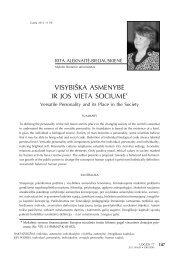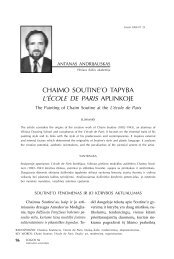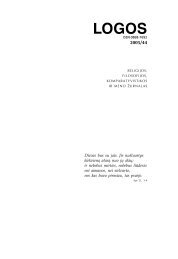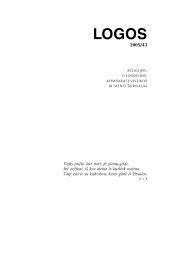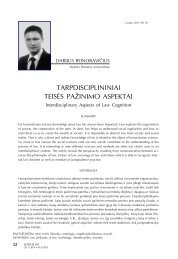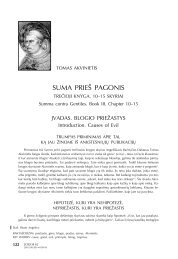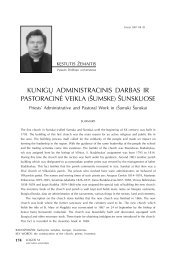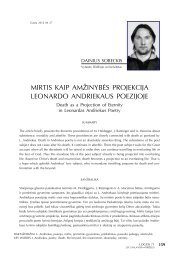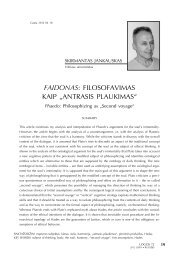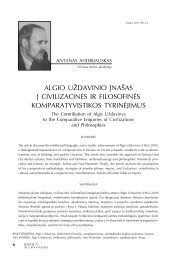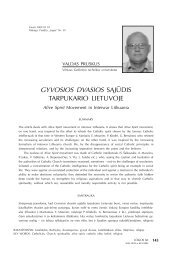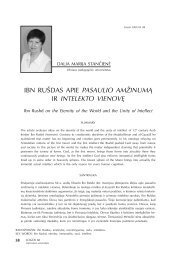Bet kvailas žmogus įgis supratimą, Kai laukinė a - Logos
Bet kvailas žmogus įgis supratimą, Kai laukinė a - Logos
Bet kvailas žmogus įgis supratimą, Kai laukinė a - Logos
Create successful ePaper yourself
Turn your PDF publications into a flip-book with our unique Google optimized e-Paper software.
Prano Dovydaièio premijai<br />
Gauta 2005-05-10<br />
ANTANAS ANDRIJAUSKAS<br />
Kultûros, filosofijos ir meno institutas<br />
GILES DELEUZE’O ESTETINËS<br />
NOMADOLOGIJOS ERDVËS<br />
The Dimensions of Gilles Deleuze‘s Nomadology<br />
SUMMARY<br />
MOKSLINË MINTIS<br />
This article is intended for the consideration of the originality of the aesthetic ideas of Deleuze. On the<br />
grounds of the analysis of principal teachings, it is shown that the originality of Deleuze’s thinking primarily<br />
became apparent in the entry of aesthetic problems into new fields of knowledge perceptible in his<br />
aesthetics of nomadology and schizoanalysis. Deleuze distanced himself from the “unifying and totalising<br />
paranoia“ peculiar to the tradition of the former rationalist aesthetics, and started speaking about the necessity<br />
of creative and revolutionary thinking inseparable from the invention of new non-classical concepts.<br />
He related that thinking to the authentic way of existence, to the personal position of the thinker,<br />
to his ability to react sensitively to the challenges of the present and to resist the infection of social conformism.<br />
The authentic nomadic thinking appears as the antipode of a sedentary stagnant life, dogmatic<br />
thinking and the comprehension of being. It defies any centralised authority and control. Therefore, it is<br />
free, creative, and independent of traditional theories and dogmas, dissociated from various obligations,<br />
servility, conformism, dogmas, and conventions which oppress sedentary thinking. This understanding is<br />
directed against the worn-out Western metaphysical and modern aesthetic dogmatism, totalitarianism, and<br />
rigid regulations which restrain personal creativity and the spontaneity of the thinker and the artist. In the<br />
article, special attention is given to the writings of Deleuze concerning the aesthetics of cinematography<br />
and visualisation. These writings present not only the peculiar system of aesthetic concepts but also changes<br />
in the 20th-century aesthetic problematic related to the expansion of the aesthetics of the mass media.<br />
Greta R. Barthes’o, M. Faucault ir kos ðalininkas buvo neklasikinës esteti-<br />
J. Derrida átakingiausias poststrukkos tradicijø tæsëjas ir reformatorius Giltûralistinës<br />
ir postmodernistinës estetiles’is Deleuze’as (1925–1995). Ðio Nie-<br />
RAKTAÞODÞIAI. Giles Deleuze, estetika, nomadologija, ðizoanalizë, media.<br />
KEY WORDS: Gilles Deleuze, aesthetics, nomadology, schizoanalysis, mass media.<br />
LOGOS 42<br />
2005 BALANDIS • BIRÞELIS<br />
115



